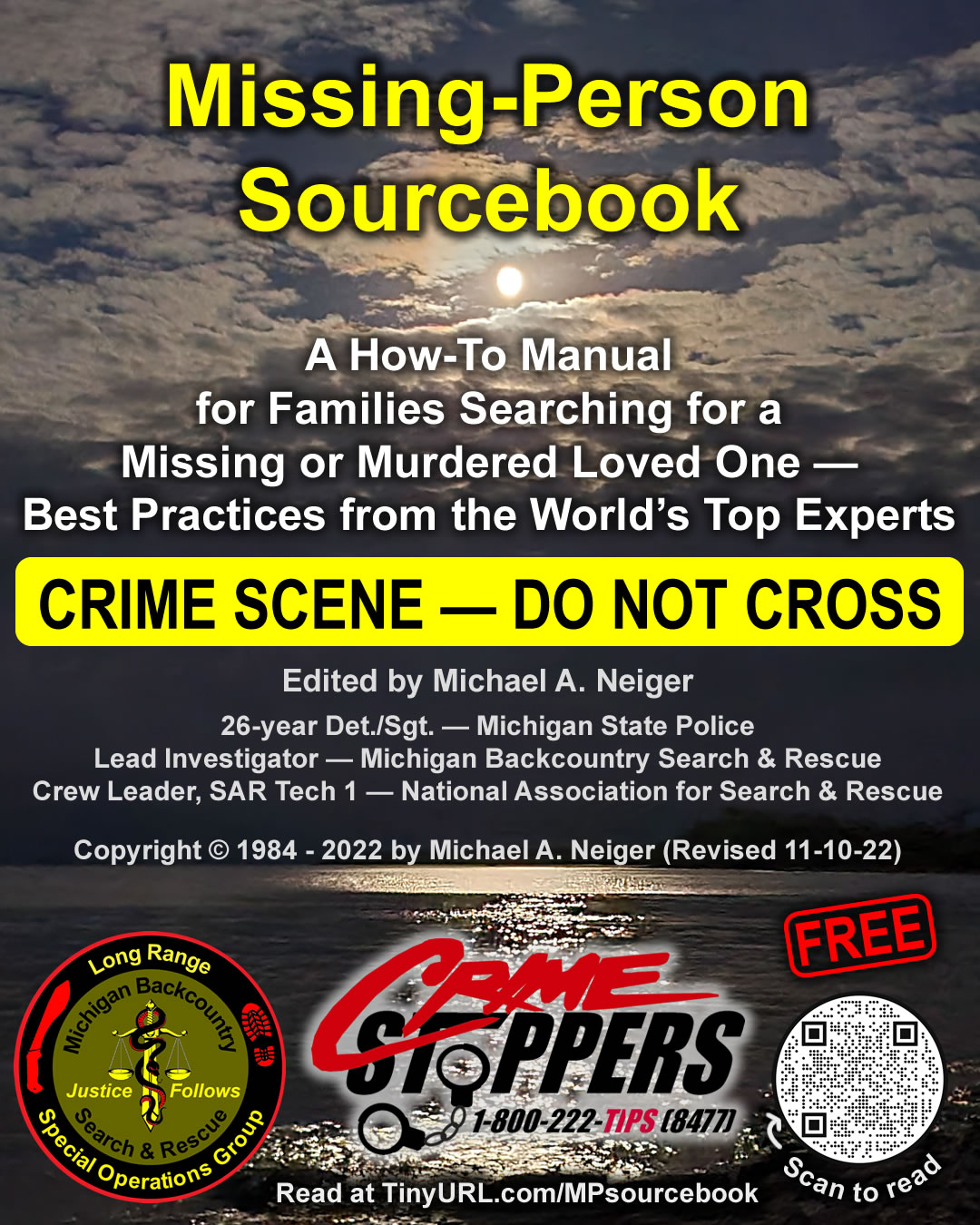
You're here: MibSAR :: M-P Sourcebook Table of Contents :: Posters
How to Leverage a Missing-Person Poster on Your Loved One's Case
| << Prior Chapter | Next Chapter >> |
Consider creating a missing-person poster for your loved one's case as it will help keep the case alive and encourage tip reporting.
Posters can be leveraged by sharing them digitally on social media — especially Facebook — and by posting hard-copies in locations where your loved one went missing or may be located.
An eye-catching poster also makes it very easy for news media outlets to do a story about your loved one as they contain basic case information as well as a high-quality graphic.
Page contents:
| Poster Tips | How to Make a Poster |
 |
|
| When Your Child Is Missing: A Family Survival Guide, by the Office of Juvenile Justice and Delinquency Prevention (OJJDP) | |
Photo and Flier Distribution
Distributing pictures of and information about your missing child is an essential part of the search and recovery process. During the first 48 hours, it is critical that recent pictures of your child and facts pertinent to the disappearance be given to law enforcement, the news media, and nonprofit organizations and agencies.
The more people who know that your child is in danger and what your child looks like, the better the chances are that someone will recognize your child and report his or her whereabouts.
— Claudine Ryce, parent of Jimmy Ryce, who was found murdered on
December 9, 1995.
Physical traits and personality characteristics should also be described as specifically as possible. This chapter contains important tips about photo and flier distribution and can guide you through both the short- and long-term process.
Distributing pictures of and information about your missing child is an essential part of the search and recovery process.
During the first 48 hours, it is critical that recent pictures of your child and facts pertinent to the disappearance be given to law enforcement, the news media, and nonprofit organizations and agencies. Physical traits and personality characteristics should also be described as specifically as possible.
This chapter contains important tips about photo and flier distribution and can guide you through both the short- and long-term process.
Photo and Flier Distribution:
The
First 48 Hours
Search for the most recent pictures.
Don’t look for pictures in your scrapbook. If you have a camera that uses film, see if there is undeveloped film in it; if so, take it to be developed. Ask family members and friends if they have recent pictures or videos of your child from a birthday party, holiday celebration, sports event, or school outing. Almost always, your child’s school will have a copy of the latest school picture or will be able to tell you the name and telephone number of the school photographer. Even a passport picture, school identification card, or driver’s license is better than nothing.
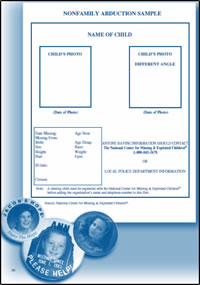 |
|
| Sample missing-person poster in When Your Child Is Missing: A Family Survival Guide, by the Office of Juvenile Justice and Delinquency Prevention (OJJDP) | |
Pick out pictures that most resemble your child.
Remember that posters and fliers will show only the head, neck, and top of the shoulders. Candid shots are fine, as long as the facial image is clear. Several pictures from different angles may give people a better idea of what your child looks like. When selecting photos, keep the purpose in mind — to enable people to recognize your child, not admire a poster that flatters but does not look like your child.
Videos or home movies are excellent choices for airing on television.
Videos capture your child’s appearance, mannerisms, and voice quality. They offer the added advantage of engaging the hearts of viewers, who can relate to the image on the screen as a live personality. Such viewers are more likely to be on the lookout for your child or even to volunteer to help in the search effort.
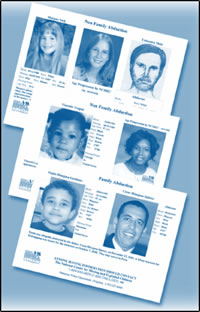 |
|
| Sample missing-person poster in When Your Child Is Missing: A Family Survival Guide, by the Office of Juvenile Justice and Delinquency Prevention (OJJDP) | |
Ask someone to have copies made of the pictures and videos you select.
Photographs can be scanned and copies made quickly at most businesses that make prints of photos. Some businesses may give you a discount rate if you give them your child’s case number showing that you have reported your child as missing to the police.
Put all photo originals and negatives in a safe place and make copies.
Never give away your only copy of a picture, unless you don’t care if you get it back.
If the picture was taken by a professional photographer, you may need to get per- mission to have the picture reproduced.
Under most circumstances, professional photographers will be glad to help by giving permission to reproduce a picture once you explain your situation. Some may even reproduce the pictures for you free of charge, so don’t be afraid to ask.
At the same time, if possible, have the pictures digitized and store them on your computer so they can be used to send the picture by e-mail to nonprofit organizations across the country that have access to the Internet.
Put someone persuasive in charge of photo
distribution.
Ask your photo distribution coordinator to keep a log showing who was given a picture or videotape, then to follow up to make sure that the photographs were distributed. In addition to local media outlets, local civic and business groups, and volunteer groups, copies of your child’s photograph can be sent to local government agencies.
Permission can be obtained from county commissioners, agency officers, or whoever has authority to post your child’s fliers in buses, at bus and sub- way stops, in tollbooths, at rest stops, and in federal and state parks and buildings.
Get as many individuals and organizations as possible to distribute your child’s picture.
Start with your neighbors and friends. Then call NCMEC, your state missing children’s clearinghouse, and private, nonprofit missing children’s organizations in your state and surrounding states, eventually blanketing the country.
Contact AMECO (www.amecoinc.org) for the names of nonprofit missing children’s organizations in your region. Ask them to distribute your child’s picture through their networks and to display it on their Internet site. Make use of today’s high-speed communication links to distribute your child’s picture throughout the country.
If you are not hooked up to the Internet, contact someone who is.
The Internet allows you to transmit clearer pictures of your child more quickly and less expensively than you could by fax. First, you must have your child’s picture scanned and digitized — that is, put on a computer disk.
A print or computer shop can provide this service to you. Next, call individual organizations to obtain their e-mail addresses. Now, you can simultaneously send your child’s digitized photo by e-mail to a wide variety of organizations.
Ask your photo distribution coordinator to find out where your child’s picture has
been posted.
Check the Internet sites of NCMEC, your state missing children’s clearinghouse, local media Web sites, and private missing children’s organizations to find out where your child’s picture has been distributed.
Expand the area of distribution to cover the entire country during the second 24-hour period by including the U.S. Customs Service, Border Patrol, and Coast Guard.
Plug into NCMEC’s photo distribution services.
NCMEC posts photos of missing children on its Web site (www.missingkids.com). On average, 127,901 visits are made on the site each day, and many companies and agencies have links to this site.
In addition, NCMEC can coordinate national media exposure through its partnership with major news- papers, magazines, television networks, and corporations.
Ask your primary law enforcement contact to request that NCMEC send a broadcast fax to its network of law enforcement agencies.
NCMEC has the capability to broadcast fax posters and other case-related information to more than 26,000 law enforcement agencies, FBI Field Offices, state missing children’s clearinghouses, the Border Patrol, and medical examiners’ offices throughout the country.
NCMEC can send your child’s picture to its network of agencies as soon as your law enforcement agency or the investigating agency makes a request.
NCMEC case management personnel are available on-call to make emergency posters, broadcast faxes, and distribute photographic images in the evenings and on weekends.
If your child has been abducted and is in danger, ask law enforcement or NCMEC to contact America’s Most Wanted on your behalf.
You need to ask either NCMEC or your law enforcement agency to make this call. America’s Most Wanted can be reached by calling 800–CRIMETV (800–274–6388). The program can run a missing children alert, which is a public service announcement showing your child’s picture.
Photo and Flier Distribution:
After the First 48 Hours
After the first 48 hours, draw on your imagination and the ideas of your many contacts to keep your child’s picture and story alive before the public. Here are some ideas of what can be done.
Be creative and aggressive in getting your child’s posters put up in heavily trafficked areas across the country.
Get approval for your mail carrier to place fliers in mailboxes. Ask utility companies to distribute fliers as their meter readers make their routes. Ask churches to request that their members include your child’s flier in Christmas cards and other letters.
Ask banks and other groups that make regular mailings to include copies of your child’s flier. Ask Federal Express, United Parcel Service, local pizza companies, and other delivery companies to distribute fliers on their routes. Ask trucking lines or moving companies to post pictures on the backs of their trucks.
Ask airline pilot and flight attendant unions to request that members post fliers in cities where airline personnel lay over. Call motorcycle clubs and other groups that hold national meetings to see if their members will take along fliers for distribution.
If anyone helping you has difficulty convincing a company to post or distribute your child’s picture, you personally should get on the phone because it is harder to say no to a victim parent. The checklist Distributing Fliers contains further tips for flier production and distribution.
Prepare a press kit for distribution to national news and talk shows and magazines.
Ask local public relations firms or persons with writing ability to help you prepare the kit and to secure e-mail and street addresses. Be sure to include local and regional radio stations. Your law enforcement agency can also give you guidance on press kit preparation.
Look for events where volunteers can distribute fliers. Have volunteers research and make a list of events such as sports contests, county fairs, festivals, and concerts planned in your community, state, and region. Distribute fliers to those events as part of your overall canvassing plan.
Send press releases and arrange interviews during special or seasonal events.
Consider celebrating your missing child’s birthday by reading aloud cards or special messages you hope he or she will hear. Speak at what would have been your child’s graduation from elementary or middle school.
Distribute age- progressed photos of your child and updated case information to refresh people’s memories and renew interest in your child’s plight. Enlist the aid of celebrities and politicians who can help publicize your child’s case.
Continue to work with NCMEC and its photo distribution program.
More than 300 private-sector participants use NCMEC’s print photographs, and a number of federal agencies feature NCMEC photos in their buildings.
Valassis’s “Have You Seen Me?®” program, which features the names and faces of missing children, reaches more than 60 million households through weekly newspaper distribution and reaches 90 percent of American homes via shared mail.
NCMEC distributes posters of missing children monthly to all Wal-Mart stores and Sam’s Clubs across the country.
Make your own picture cards to insert in mass mailings.
Get permission from government agencies, utility companies, and private businesses to have your card inserted in newspapers and envelopes containing state license renewals, tax assessments, local utility bills, payroll envelopes, and bank statements.
Talk to direct-mail advertising companies to gain access to mass coupon mailings.
Ask national groups for help.
Ask law enforcement associations, women’s auxiliary groups, civic groups such as the Rotary Club or Elks and Moose lodges, the Chamber of Commerce, military groups or associations such as the Veterans of Foreign Wars, and college fraternities to distribute and post your child’s poster or flier.
Ask a variety of franchise businesses to distribute posters through their normal supply lines.
Consider especially various fast food and gasoline chains. Individuals who know who has abducted or who is holding your child may frequent liquor stores and adult bookstores more often than banks, post offices, and schools. Reward posters should be posted where people with information are most likely to see them.
Consider using publicity gimmicks to etch your child’s face in the public’s memory.
Have your child’s picture printed on buttons, T-shirts, bumper stickers, stamps, and baseball-type cards.
Appear on talk shows on the condition that your child’s picture is shown during the program.
Be sure that the subject of the talk show is compatible with the seriousness of your child’s situation and that the show’s topics and other guests can be verified prior to your appearance.
Make sure that the storyline will help, not harm, you and your child. Steer clear of sensational shows that focus on serial child murders, child sexual exploitation, or other issues that can take the focus away from your case.
- During the first 48 hours, it is critical that recent pictures of your child, descriptions of physical traits and personality characteristics, and facts pertinent to the disappearance be given to law enforcement, the news media, and nonprofit organizations and agencies.
- Distribute only recent pictures that resemble your child. Remember that posters and fliers will show only the head, neck, and top of the shoulders.
- Choose representative videos or home movies for airing on television to show viewers your child’s appearance, mannerisms, and voice quality.
- Never give away your only copy of a picture or video. Have photos scanned for electronic distribution and make electronic copies of videos.
- Be both creative and aggressive in getting your child’s posters put up in heavily trafficked areas across the country.
- Use publicity gimmicks, such as buttons, T-shirts, and bumper stickers, to etch your child’s face in the public’s memory.
- Prepare a press kit for distribution to national news and talk shows and magazines.
- Extend your search to the Internet, which will allow you to send your child’s picture to a wide variety of organizations via e-mail more quickly and less expensively than you could by fax.
- Plug into available photo distribution services, including NCMEC, which can coordinate national media exposure, send a broadcast fax to its national network of law enforcement agencies, contact America’s Most Wanted requesting that a public service announcement be aired on your behalf, and post photos of your child on its Web site.
- If your child has been missing for a long time, distribute age-progressed photos and updated case information to refresh people’s memories and renew interest in your child’s plight.
Effective fliers creatively combine photographs with basic information about your child.
The following checklist can help you develop strategies for increasing the visibility of your child’s case and generating possible leads about the disappearance.
Ask someone creative to take charge of flier and poster production.
Friends, family members, and volunteers can help with this task. Your poster coordinator can ask local printers to produce fliers free or at a discount rate.
Have fliers printed in different sizes for different purposes.
Use different sizes for buttons, handouts, reward posters, mailings, and labels. Use the samples in this chapter as a guide.
Ask your primary law enforcement contact what telephone number should be published on the flier for people to use to call in tips.
Because the purpose of fliers is to generate leads and tips relevant to your child’s case, it is crucial to include a special phone number for readers to call.
Often, law enforcement prefers to use a 24-hour hotline staffed by trained information takers rather than the local police telephone number, which may revert to voice mail or a beeper when no one is in the office.
The NCMEC toll-free number can be used only after your child has been reported missing to NCMEC. Crime Stoppers and other reputable hotlines experienced in taking lead information are other possibilities.
If you ask, Crime Stoppers may be willing to give and take reward information. Do not use your own telephone number or establish your own 800 number. You need to keep your own phone line free for your child or the person holding your child to call.
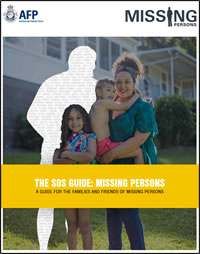 |
|
| The SOS Guide: Missing Persons — A Guide for the Families and Friends of Missing Persons, by the National Missing Persons Coordination Centre (NMPCC) | |
Missing-Person Posters
- Create a missing person poster, featuring the person’s details (name, age, physical description), last known whereabouts, and a clear, recent photo. A clear heading ‘MISSING PERSON’ or ‘HAVE YOU SEEN ME?’ will help. If the missing person is already profiled on the national register, you can download a poster with their relevant information from their profile page on the website.
- Posters should also have clear contact details for people to provide any information they may have. Across Australia, Crime Stoppers (1800 333 000) is used for this purpose. Do not use your own private or mobile phone numbers.
- If you need assistance with printing, Officeworks has a monthly community service budget. Members of Parliament also work to support the local community and their local office may be able to assist you with printing your posters.
- Contact local community groups to help distribute the poster, and keep a list of where posters are distributed and displayed to avoid duplication.
- Consider displaying posters in places the missing person is known to visit and also areas such as: shopping centres; bus stops, and railway stations; at local sporting and entertainment venues; libraries; local councils; gyms; clubs and community centres.
 |
|
| The Polly Klass Foundation (PKF) guide to creating a missing-person poster |
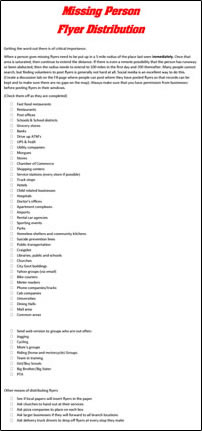 |
|
| Missing Person Flyer Distribution, by 4 The Missing |
This document lists 54 potential places or ways to circulate a missing-person poster.
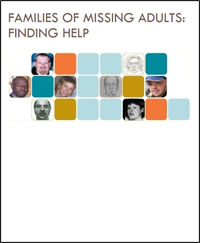 |
|
| Families of Missing Adults: Finding Help, by Ontario's Missing Adults (OMA) |
Read page 13 to learn more about missing-person posters.
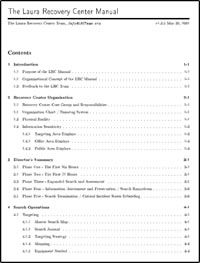 |
|
| The Laura Recovery Center Manual, by the Laura Recovery Center (LRC) Team |
Read pages 5.2 thru 5.6, 5.17, and 6.2 for information on missing-person posters.
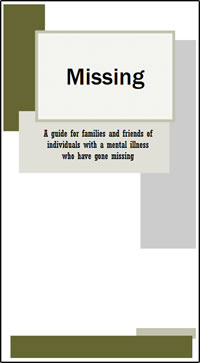 |
|
| Missing: A Guide for Families and Friends of Individuals with a Mental Illness Who Have Gone Missing, by Christine Lafond, Stephanie Scherbain & Gita Sud, Mental Health Education Resource Centre of Manitoba |
Read pages 12-15 for more information on missing-person posters.
How to Create a Missing-Person Poster
 |
|
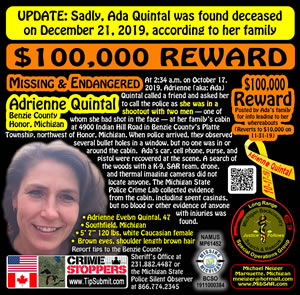 |
|
A free, social-media-friendly missing-person poster designed for Ada Quintal's family by Michael Neiger. View a high-resolution copy here. |
For more information, contact Michael Neiger at mneiger@
hotmail.com
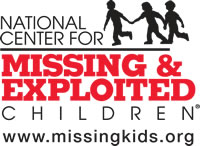 |
|
 |
|
| A National Center for Missing & Exploited Children (NCMEC) poster. |
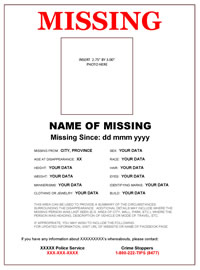 |
|
| The Canadian Centre for Information on Missing Adults (CCIMA) do-it-yourself Microsoft Word missing-person poster template. |
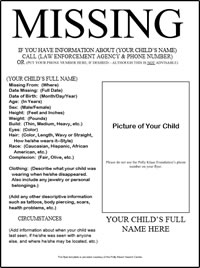 |
|
| The Polly Klass Foundation (PKF) do-it-yourself Microsoft Word missing-person poster template. | |
 |
|
| The Polly Klass Foundation (PKF) guide to creating a missing-person poster |
PKF also has 3-page, instructional guide to creating a missing-person poster.
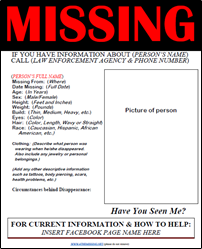 |
|
| The 4 The Missing (4TM) do-it-yourself Microsoft Word missing-person poster template. |
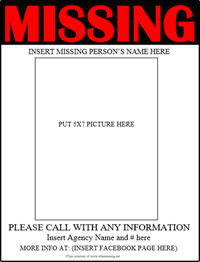 |
|
| The 4 The Missing (4TM) do-it-yourself Microsoft Word missing-person poster template. |
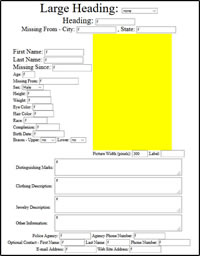 |
|
| The Laura Recovery Center (LRC) do-it-yourself online missing-person poster creation program |
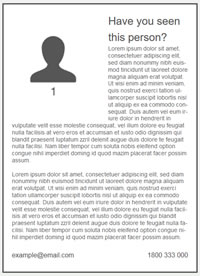 |
|
| Missing Person Guide, by the Missing Persons Advocacy Network (MPAN), do-it-yourself online missing-person poster program |
| << Prior Chapter | Next Chapter >> |
People who say it cannot be done,
should not interrupt those who are doing it.
— Author unknown

If you've been able to read this
Web page...
thank a Teacher;
If you've been able to read this
Web page in English...
thank a Veteran.
— Author unknown
Copyright © 1984-
March 23, 2021
by Michael A. Neiger
Contact Michael Neiger via e-mail at mneiger@hotmail.com
Top
You're here: MibSAR :: M-P Sourcebook Table of Contents :: Posters